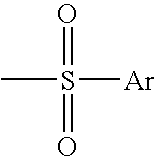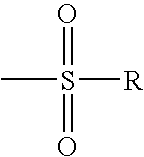Thienoisoxazole phenoxy unsubstituted ethyl and propyl derivatives useful as d4 antagonists
a technology of thienoisoxazole and which is applied in the field of thienoisoxazole phenoxy unsubstituted ethyl and propyl derivatives useful as d4 antagonists, can solve the problems of not meeting the criteria, not being able to meet the requirements of the normal synthesis process, and not being able to achieve the synthesis process
- Summary
- Abstract
- Description
- Claims
- Application Information
AI Technical Summary
Problems solved by technology
Method used
Image
Examples
example 1
Preparation of (3-fluoro-benzyl)-[2-(3-thieno[2,3-d]isoxazol-3-yl-phenoxy)-ethyl]-amine maleate (Scheme II, Compound 1)
MDL 814009
[0127]Generally, for steps A, B, and D: NMR spectra were recorded using a Varian XL-300 spectrometer at 300 MHz for 1H and 75 MHz for 13C. All chemical shifts are reported in ppm relative to TMS standard. GC / MS was accomplished using a Hewlett Packard Model 5972 with the following parameters: 30 meter HP 5MS column, i.d. 0.25 mm, film thickness 0.25 μm; heating rate −50° C. for 1 minute, then 20° C. / minute up to 300° C.; injector temperature, 250° C.; detector temperature, 280° C. The mass spectrum was obtained on a Finnigan Mat TSQ 700 spectrometer. Microanalyses were done by Robertson Microlit, Madison, N.J.
[0128]For steps C, E, F, G and H: NMR spectra were recorded using a Gemini 300 spectrometer. IR spectra were recorded on a Mattson Galaxy 500 FTIR. Mass Spectra were obtained on a Finnigan MAT4600 spectrometer. Elemental analyses were performed by Rob...
example 1a
Alternative Preparation of (3-fluoro-benzyl)-[2-(3-thieno[2,3-d]isoxazol-3-yl-phenoxy)-ethyl]-amine (Scheme I(a), Compound 1)
Step H:
Preparation of (2-bromo-ethyl)-(3-fluoro-benzyl)-amine (Scheme I(a), Compound 9)
[0145]
[0146]Combine 3-fluorobenzylamine (5.0 g, 0.0400 mol), fused sodium acetate (3.28 g, 0.0400 mol) and 1,2-dibromoethane (7.51 g, 0.0400 mol) and reflux for several hours. Pour the mixture into water and add sodium carbonate to create a basic pH. Remove the unreacted 1,2-dibromoethane by distillation. Extract the left-over residue with ether and evaporate to obtain the final, desired compound. The compound can form the hydrochloride salt.
Step I:
Preparation of (3-fluoro-benzyl)-[2-(3-thieno[2,3-d]isoxazol-3-yl-phenoxy)-ethyl]-amine (Scheme I(a), Compound 1)
[0147]
[0148]Add dichloromethane to 3-thieno[2,3-d]isoxazol-3-yl-phenol (10 g, 0.046 mol) or the appropriately protected 3-thieno[2,3-d]isoxazol-3-yl-phenol as is known in the art, and stir with sodium hydroxide (1M; 28 ...
example 1 (
Example 1(B)
Alternative preparation of (3-fluoro-benzyl)-[2-(3-thieno[2,3-d]isoxazol-3-yl-phenoxy)-ethyl]-amine (Scheme I(b), Compound 1)
Step N:
Preparation of 2-(3-fluoro-benzylamino)-ethanol (Scheme I(b), Compound 4)
[0149]
[0150]Combine 3-fluorobenzylamine (31.1 g, 0.248 mol), 2-chloroethanol (10 g, 0.124 mol) and water (30 g, 1.66 mol) and heat on a steam-bath for ˜5 hours. Add sodium hydroxide (15 g, 0.373 mol) to the cooled solution and heat the resulting mixture on a steam-bath for ˜30 minutes. Add water (˜50 mL) to dissolve the inorganic salts and extract the two-phase mixture twice with 25 mL and 13 mL portions of benzene. Combine the extracts and remove the water by co-distillation with benzene through a modified Claisen flask. The final desired compound may be purified with further distillation.
Step O:
Preparation of toluene-4-sulfonic acid 2-[tert-butoxycarbonyl-(3-fluoro-benzyl)-amino]-ethyl ester (Scheme I(b), Compound 6)
[0151]
[0152]Add p-toluenesulfonyl-chloride (0.71 g, ...
PUM
| Property | Measurement | Unit |
|---|---|---|
| Molar density | aaaaa | aaaaa |
| Molar density | aaaaa | aaaaa |
| Molar density | aaaaa | aaaaa |
Abstract
Description
Claims
Application Information
 Login to view more
Login to view more - R&D Engineer
- R&D Manager
- IP Professional
- Industry Leading Data Capabilities
- Powerful AI technology
- Patent DNA Extraction
Browse by: Latest US Patents, China's latest patents, Technical Efficacy Thesaurus, Application Domain, Technology Topic.
© 2024 PatSnap. All rights reserved.Legal|Privacy policy|Modern Slavery Act Transparency Statement|Sitemap



